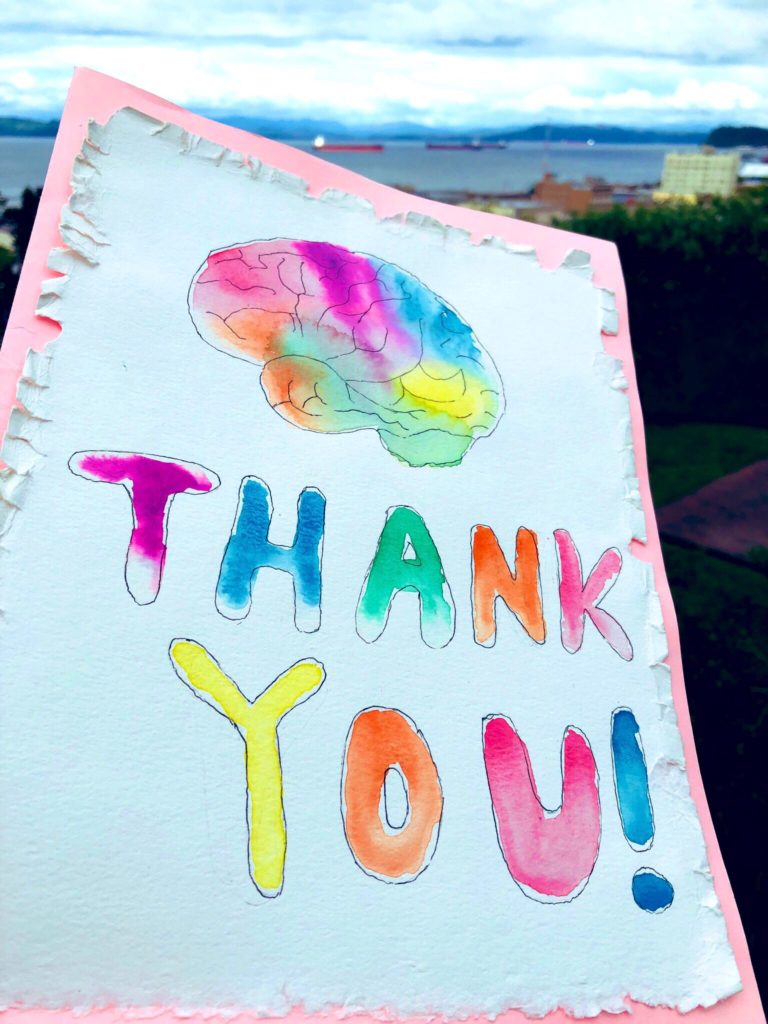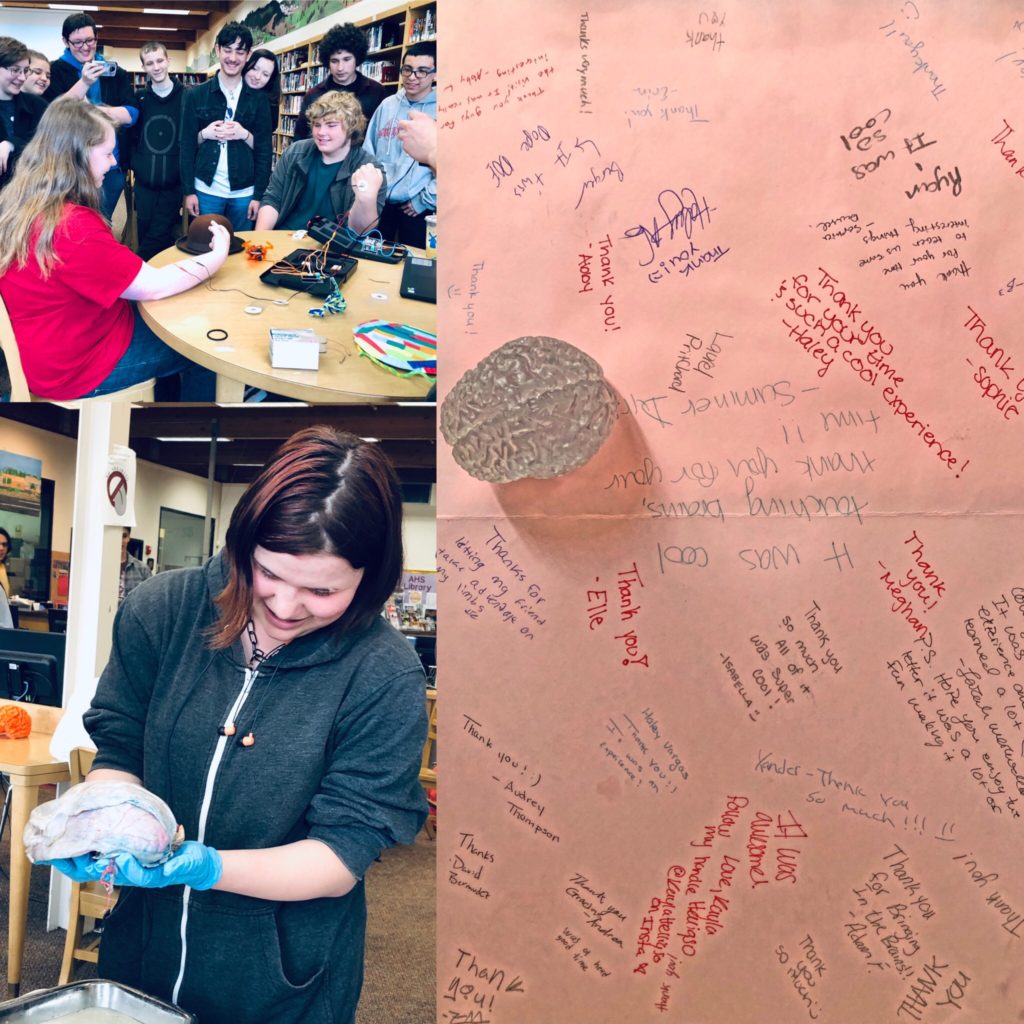Post by Angela Hendrix, NW Noggin
The nucleus accumbens is part of our brain’s mesolimbic dopamine pathway, and responds to aspects of our world which predict reward. The word ‘accumbens‘ also means to lie down…

LEARN MORE: Dopaminergic reward system: a short integrative review
NW Noggin ventured west of Portland this May, down beautiful Highway 30 to the mouth of the Columbia River, to meet with students at Astoria High School. Seven outreach aficionados spent the night in a home built in 1879, with a column of brains carved from a monkey puzzle tree out front!
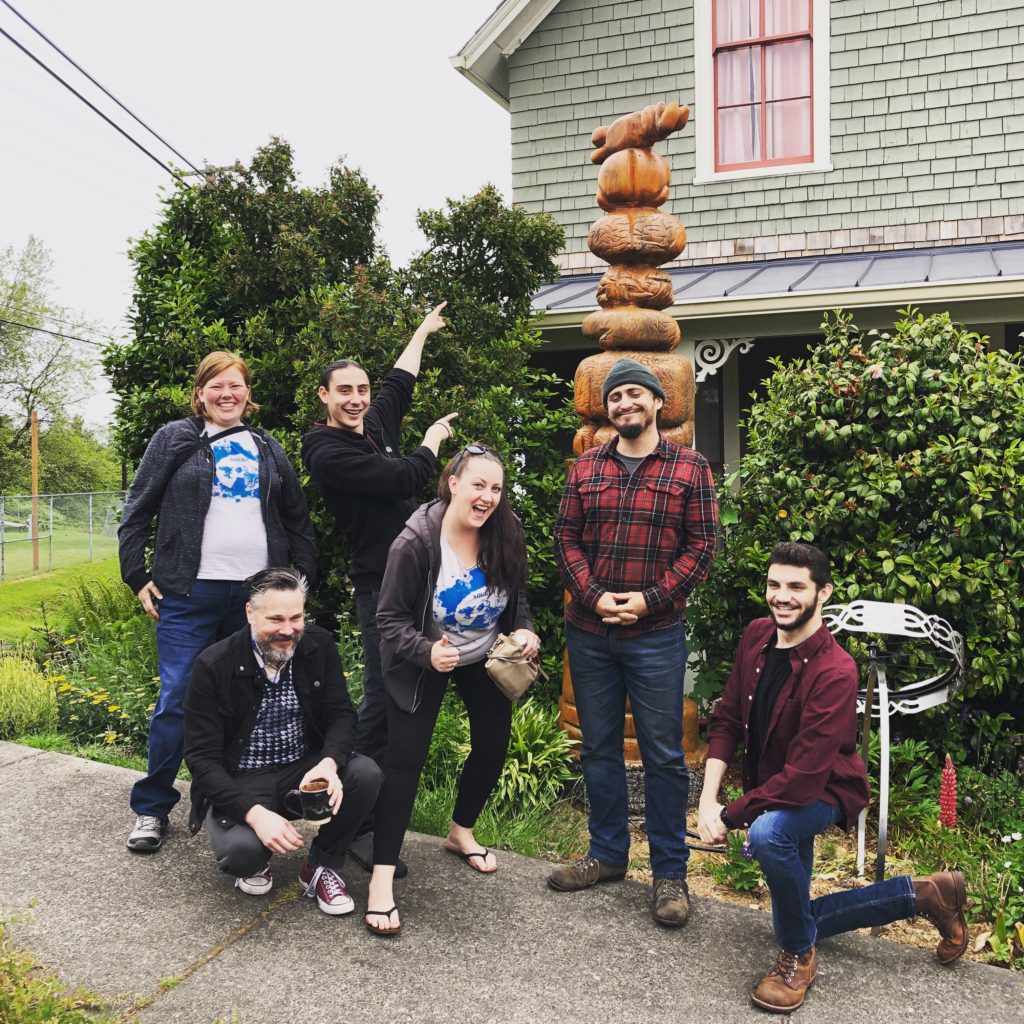
I joined Noggin co-founders Bill Griesar and Jeff Leake, Portland State University undergraduates Aaron Eisen, Michael Deveney and Jordan Ray, and Joey Seuferling, a graduate of WSU Vancouver. We enjoyed exploring this hilly, historic city – and also relaxation, deepening friendships, sharing personal stories, a gas fireplace and fun, not to mention fruit that was in season, vegan pizza, great chocolate, and delicious local beer!
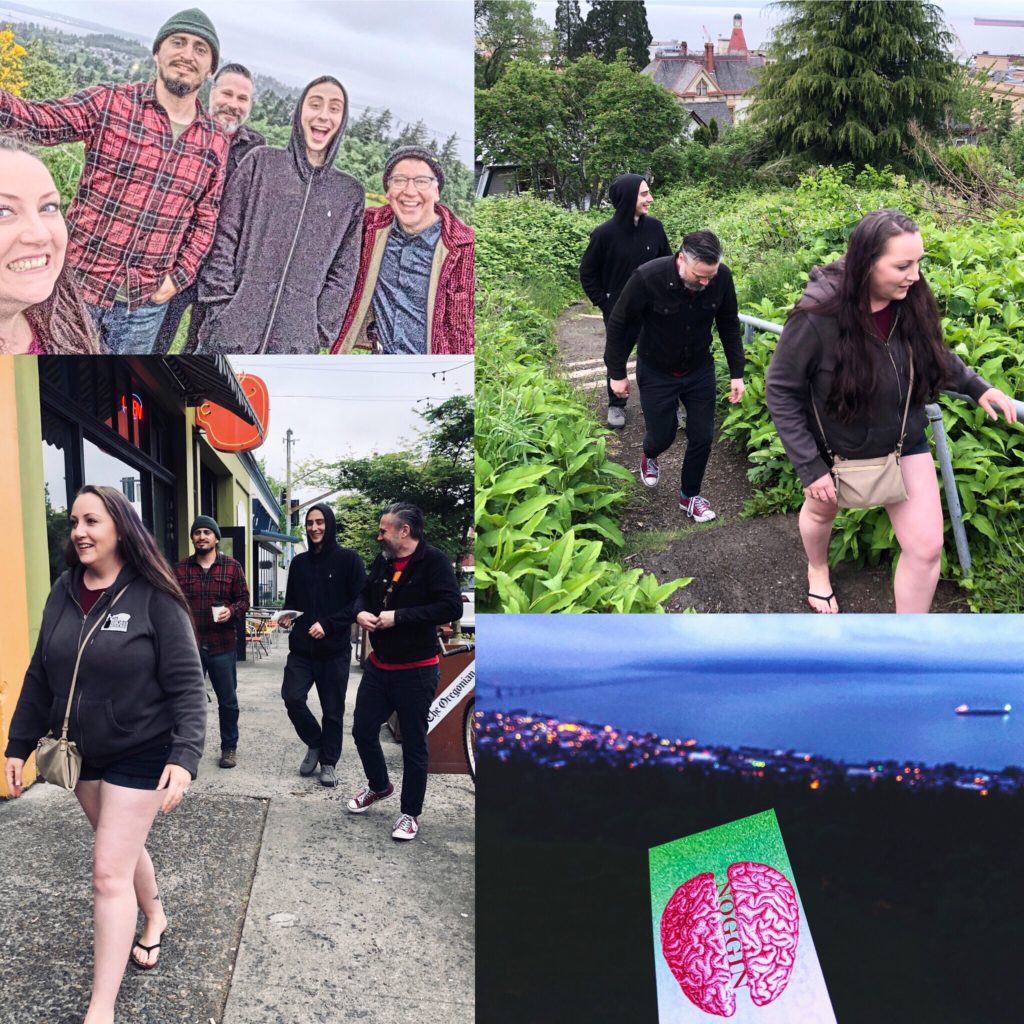
We are indebted to Meredith Payton, the Talent Search Advisor for Clatsop Community College, who arranged our planned visits with students from Astoria High School’s Human Performance, Painting, and Basic Design classes, scheduled for the following day…
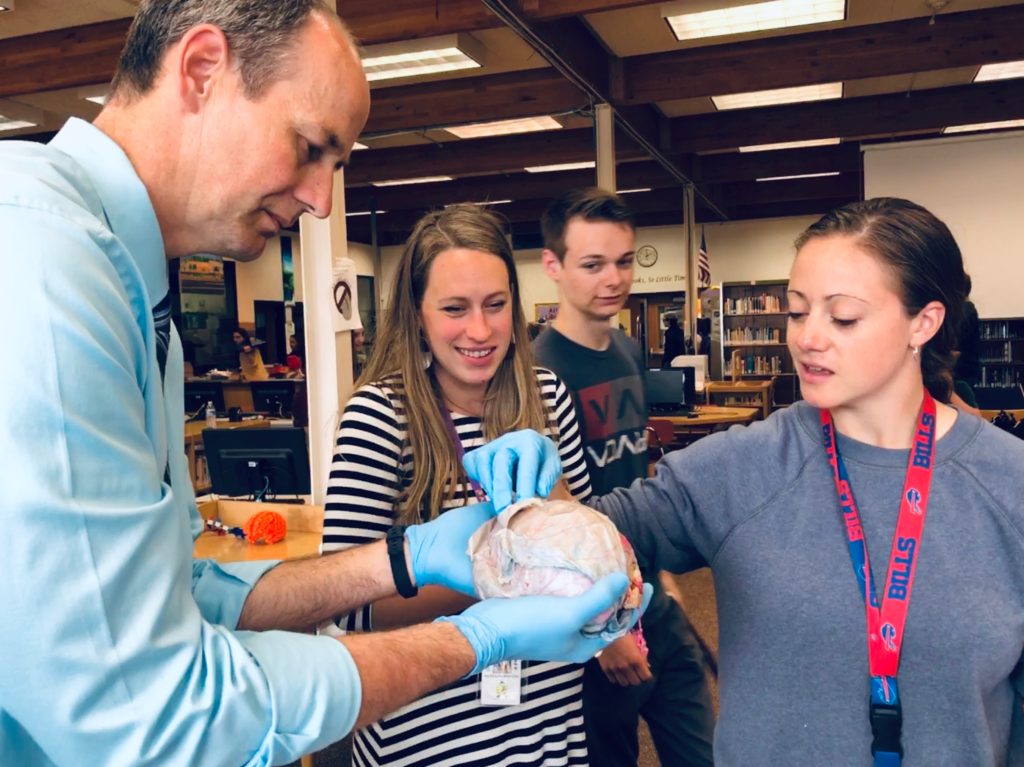
That first night, however, we related our experiences at the recent OHSU Brain Awareness lectures, and discussed our own research, educational and career hopes, endeavors and dreams. We also talked about why we volunteer with NW Noggin – mostly for the awesome, unique chance to have and help create novel and engaging learning opportunities.

Every time I’ve volunteered I have met new people, and learned new things. We all know from experience (so many experiences!) that showing up in a big group, with art that brings out our natural motivation to make things, along with open, respectful communication, and genuine curiosity about what people already know and want to know, creates extremely special opportunities for long lasting learning.
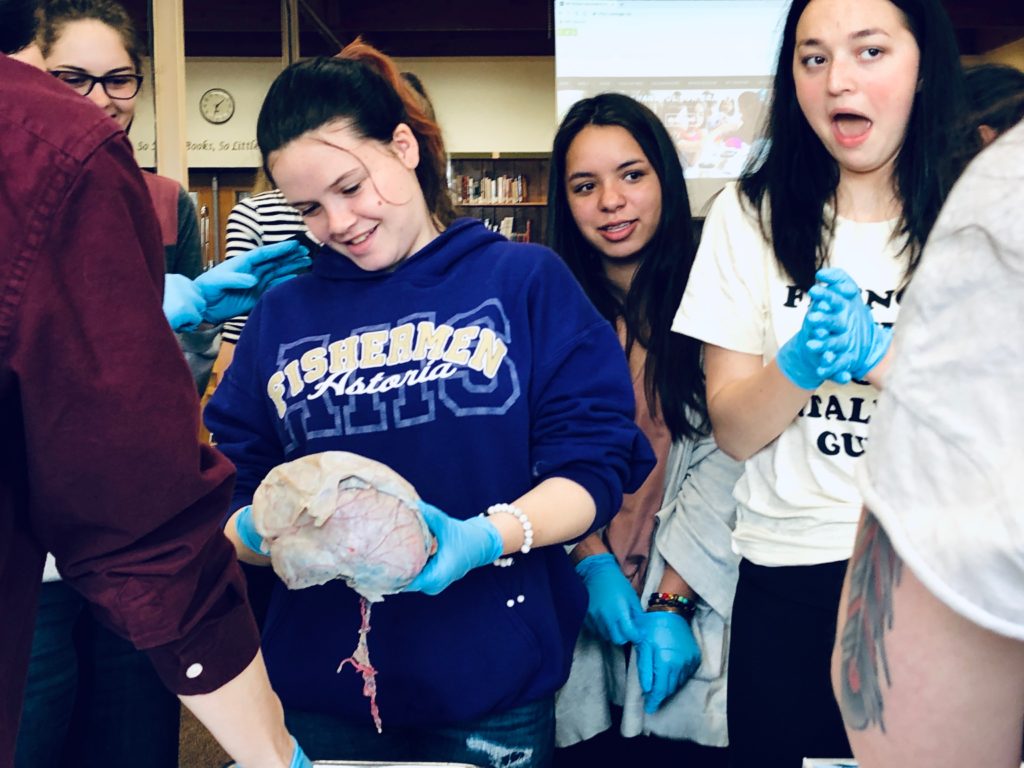
And we do dream of developing an even better understanding of the remarkable neurophysiological underpinnings of who we are. We feel we have an important job, to help inspire young people about neuroscience, to make it clear that they are welcome and essential for pursuing this better understanding, and to enthuse them about becoming the next generation of engaged artists, scientists, science communicators and policy makers – and also voters for genuinely evidence-based approaches and legislation.

A handful of us found ourselves surprised when we realized the clock had hit 3:00am! After getting a little rest, we woke up to enjoy the beautiful view of ships parked on the Columbia on a misty morning. Coffee got us going and we headed down to Astoria High School to meet with students.
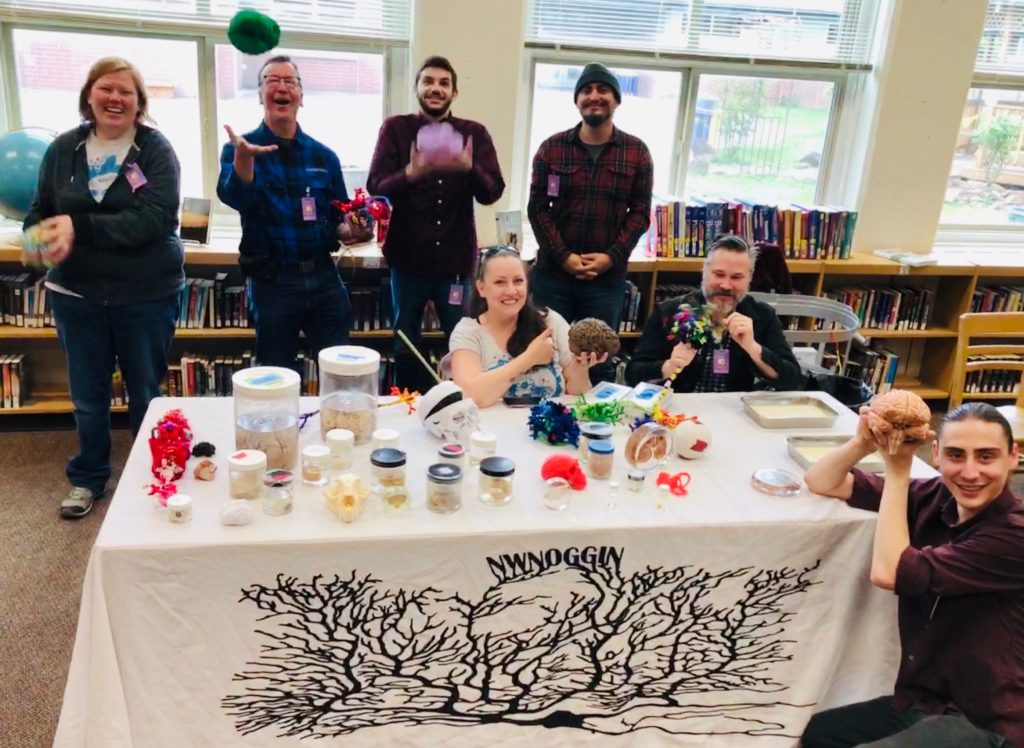
We put lots of colorful 3D printed brains and skulls on display. We brought a dozen real brains from different species to examine, and several (extra) real human brains. All the colorful and novel displays (and the brains!) really get students, staff and teachers excited.

We set up during “flex-time,” when students had choices on where to be, and a big crowd of students and teachers came through asking questions and relating what they already knew..!
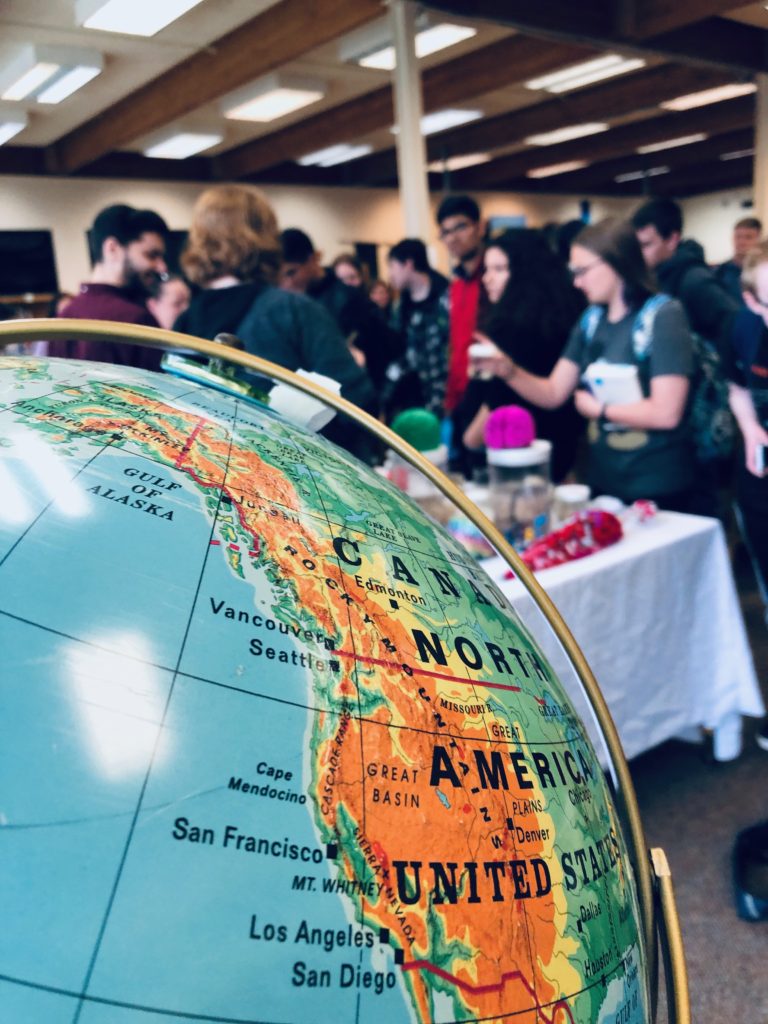
Several were interested in how visual and other perception-related regions differ in brains from animals that rely on different senses. We talked about what different species are good at, and what skills they need to negotiate their environment, and the associated brain structures involved with those functions.
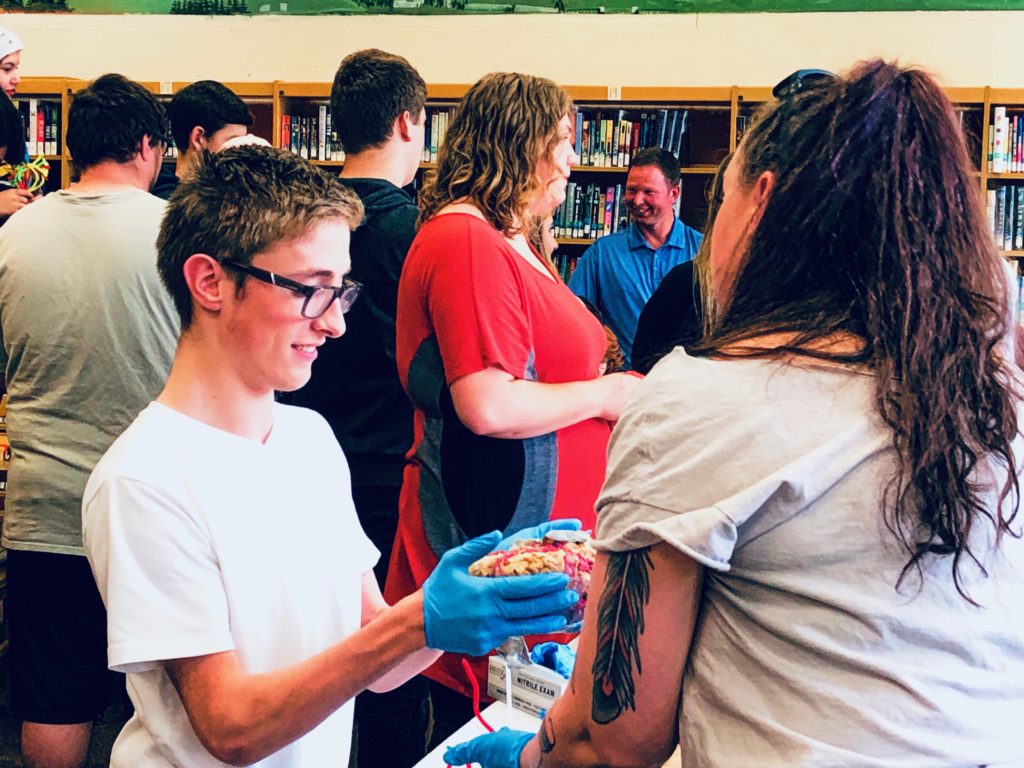
We discussed, for example, how large species like the rhinoceros, elephant and giraffe each have a very big cerebellum, because it is essential to their survival that they have great balance and avoid falls, and how birds have brains that are much much more densely packed with neuronal circuitry than ours, because they need lighter brains to fly…
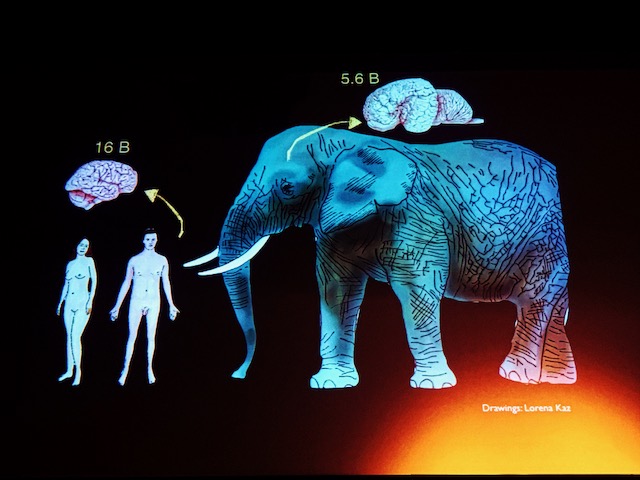
LEARN MORE (Differences in Brains): Soup for Brains!
LEARN MORE: The elephant brain in numbers
LEARN MORE: Elephants have relatively the largest cerebellum size of mammals
LEARN MORE (Vision): Tagging the temporal lobe
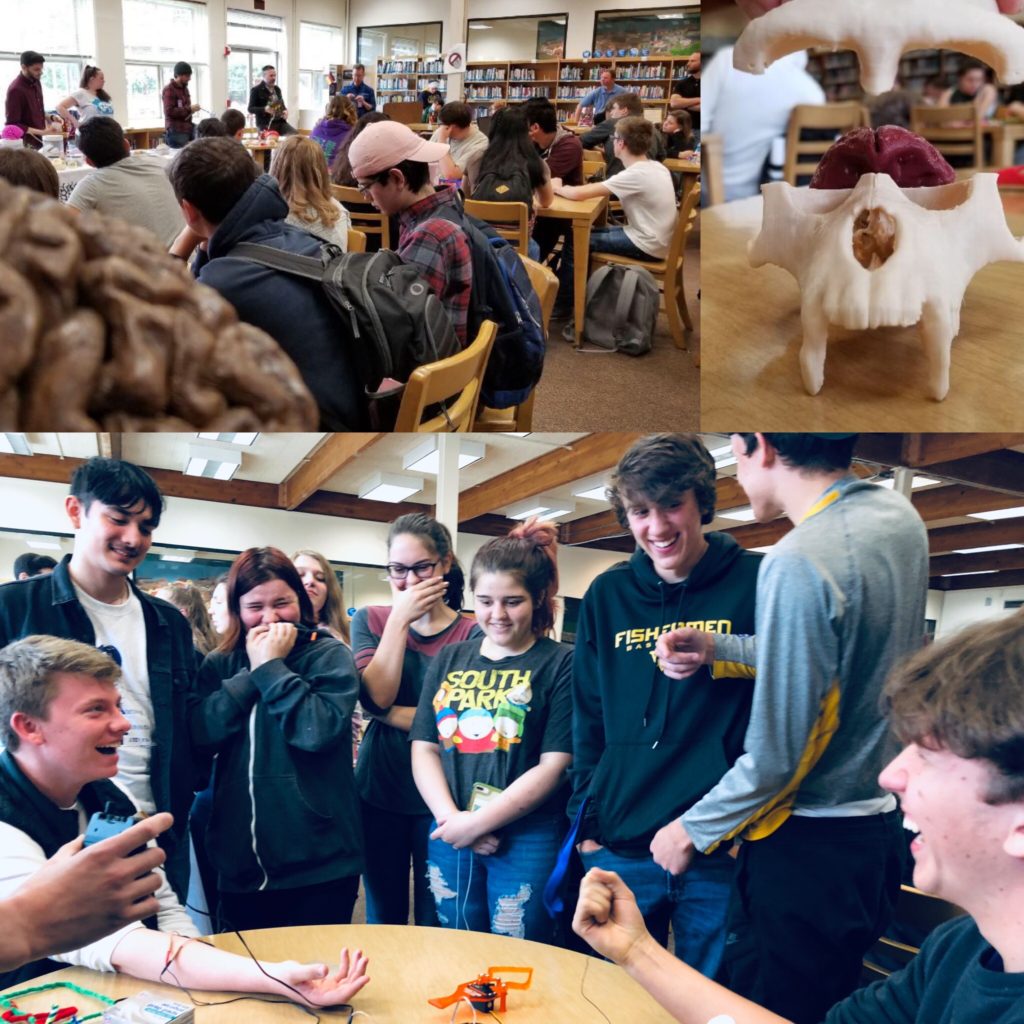
Once we got started with educator (and expert woodworker!) Chad Madsen’s Human Performance class, students were eager to make their own pipe cleaner neurons, touch brains, and use the popular Human to Human Interface to move each others’ arms through electrical impulses.
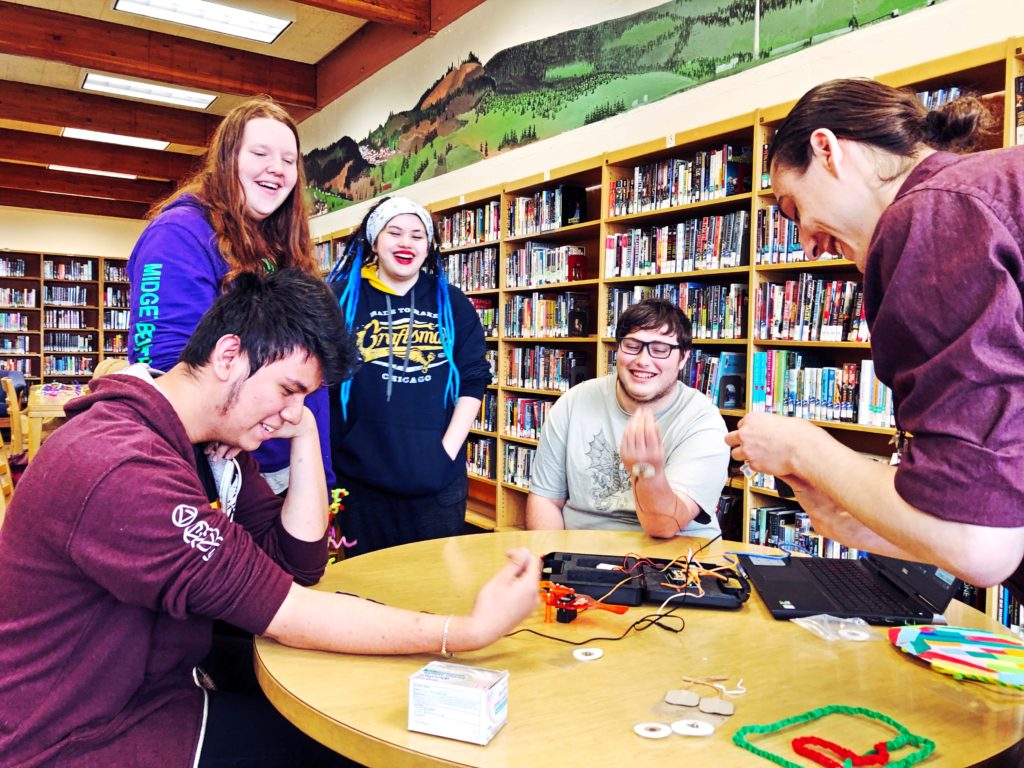
LEARN MORE: Brain Hacking is Electric!
Students asked several questions about sleep. One student was especially curious about why, when she is having poor sleep, she sometimes has intense, even terrifying dreams. Noggineer Jordan Ray, who built a low-cost EEG device to record and examine his own sleep data, explained that developing adolescent brains are “like junior chemists” when it comes to sleep. “There are complex changes in brain activity and chemicals that shift you into different sleep stages, and it doesn’t always go smoothly, particularly if you’re stressed out. But it doesn’t mean that your brain won’t figure it out.”
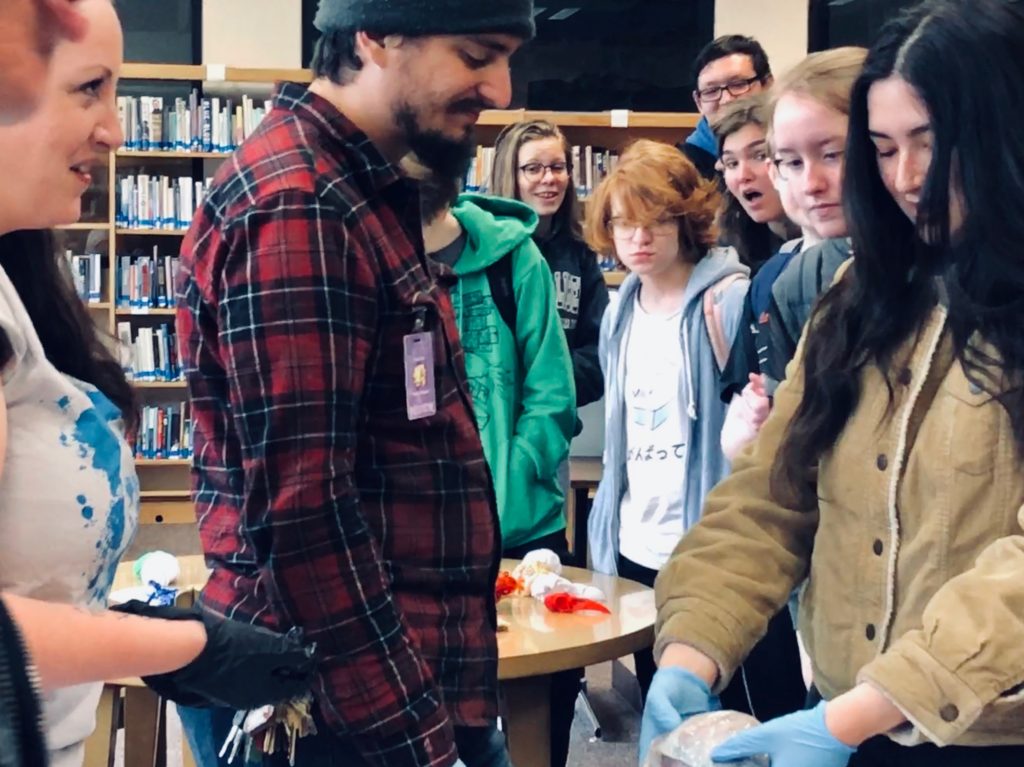
LEARN MORE: Noggins in Nod: The science of sleep
LEARN MORE: Relationships between sleep paralysis and sleep quality: current insights
LEARN MORE: Sleep Paralysis, a Medical Condition with a Diverse Cultural Interpretation
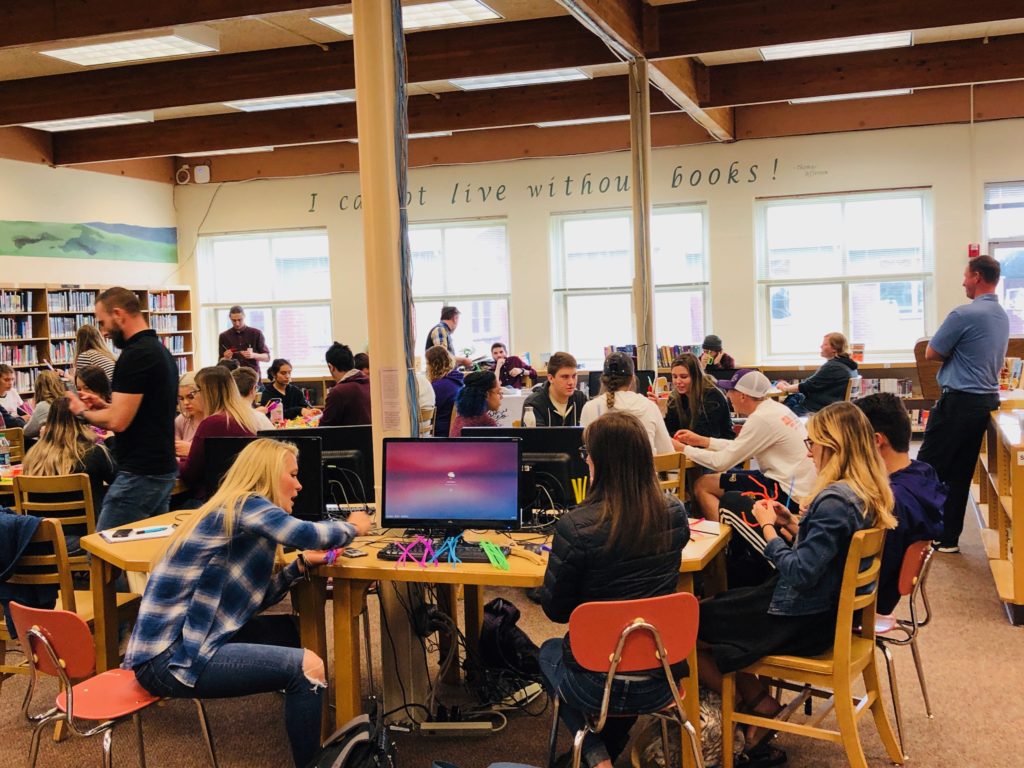
The students also had questions about how drugs, including alcohol, methamphetamine and nicotine, affect the brain. They questioned how addictive different substances are, how their age affects their risk, how we diagnose drug use disorders, and how we decide as a society what should be legal or illegal. Adolescence is a period of dramatic development in the frontal lobes of our brains, which allow for effective social decision making. Risk taking and experimentation come with this territory, but genuine, evidence-based information might help us make better choices…
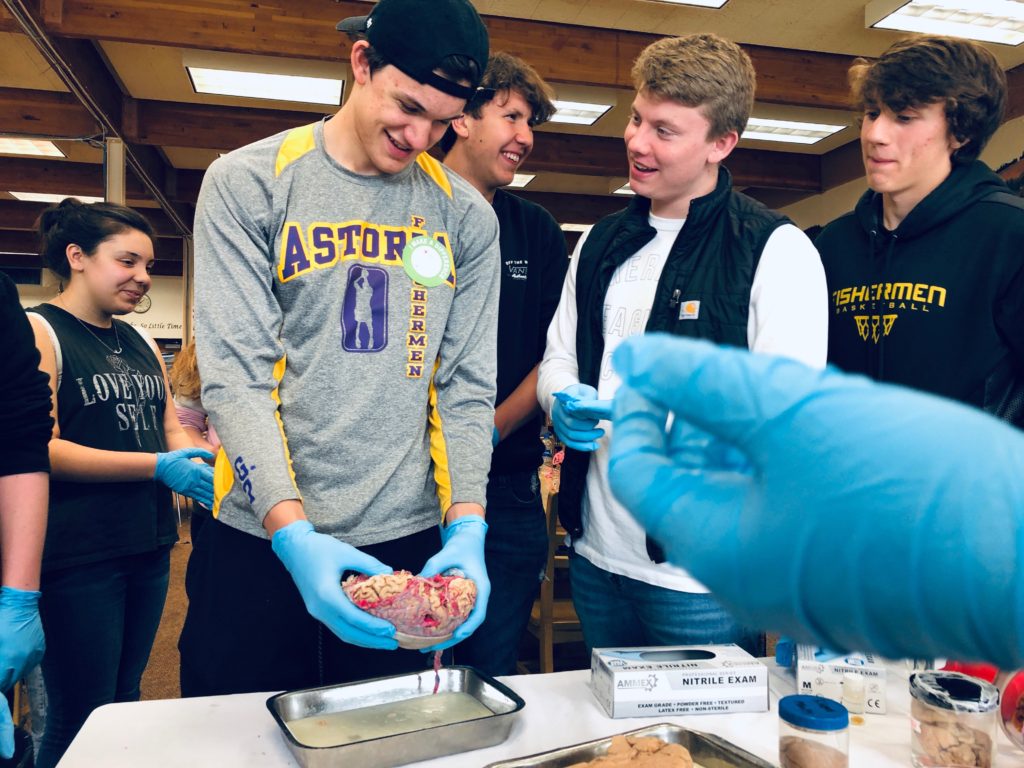
LEARN MORE: Maturation of the adolescent brain
LEARN MORE: Adolescent brain development and the risk for alcohol and other drug problems
We talked, for example, about the particularly harmful long term health effects and high dependence risk of nicotine, especially during adolescence, and how Oregon just moved the legal age for smoking from 18 to 21. Some drugs, like meth, actually damage brain cells that release dopamine in the brain, potentially decreasing your motivation and enjoyment of life…

LEARN MORE: Tobacco smoking: Health impact, prevalence, correlates and interventions
LEARN MORE: A Molecular Basis for Nicotine as a Gateway Drug
LEARN MORE: Why Nicotine is a Gateway Drug
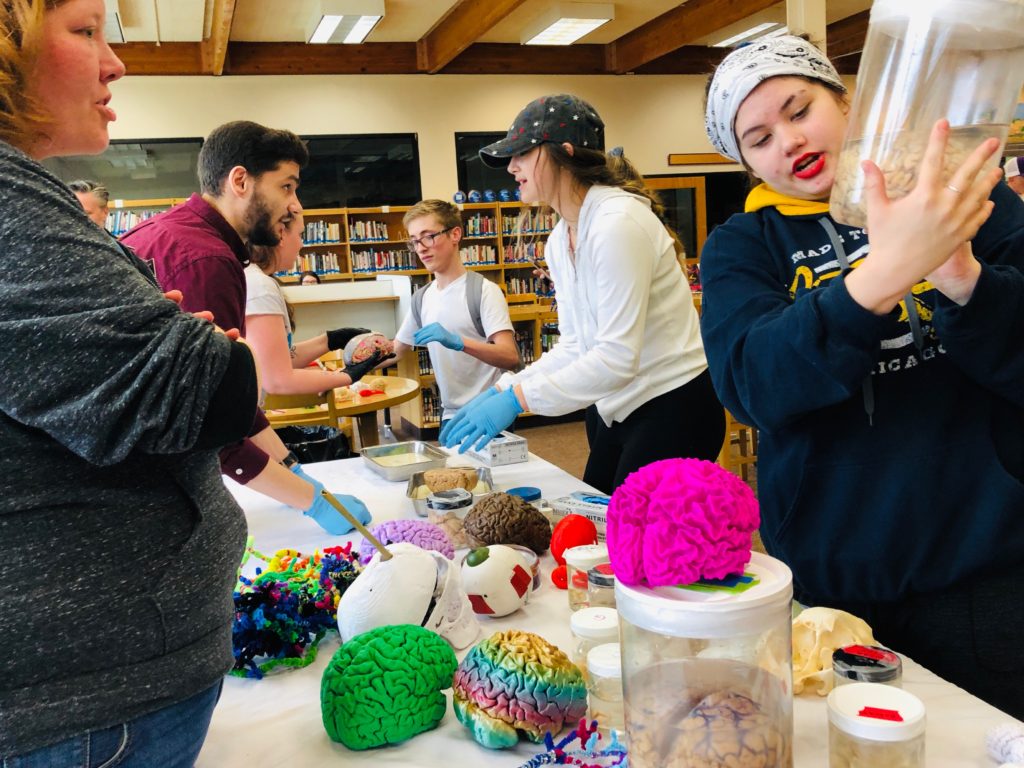
Excessive alcohol is also damaging to brains during adolescence. Bill highlighted research on how not feeling anything in response to your first drink (a “low response”), for example, did not mean that you could safely “hold your liquor.” Rather it’s a risk factor for drinking a lot more alcohol, which increases your risk of developing an alcohol use disorder.
LEARN MORE: Low level of response to alcohol as a predictor of future alcoholism
LEARN MORE: What’s a “drink..?” At the Newmark for beer & brains
LEARN MORE: Alcohol Use Disorder
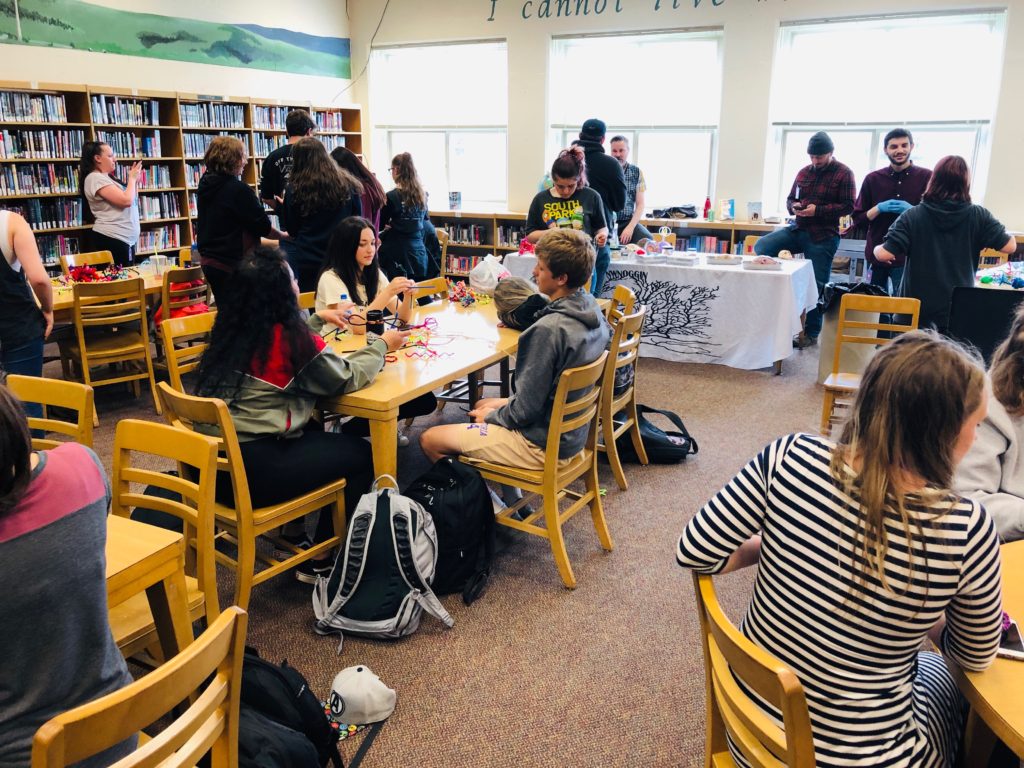
We built more pipe cleaner neurons to illustrate how brain cells carry electrical messages, and communicate with each other at tiny gaps (called ‘synapses‘) through chemicals, whether they are substances we consume (illegally or prescribed) or neurotransmitters (including dopamine) released normally in the brain for, say, happiness or motivation.

LEARN MORE: How do neurons send electrical messages?
After an exciting morning we were ready for a lunch break, and the food Micha Lattek brought us from Astoria’s Street 14 Cafe was AMAAZING!! The sandwiches looked incredible, the apple muffin deserts were delicious, and my own vegan lentil soup was the best ever! Undergrads and volunteers will do a LOT for a good meal – a million thanks Street 14!
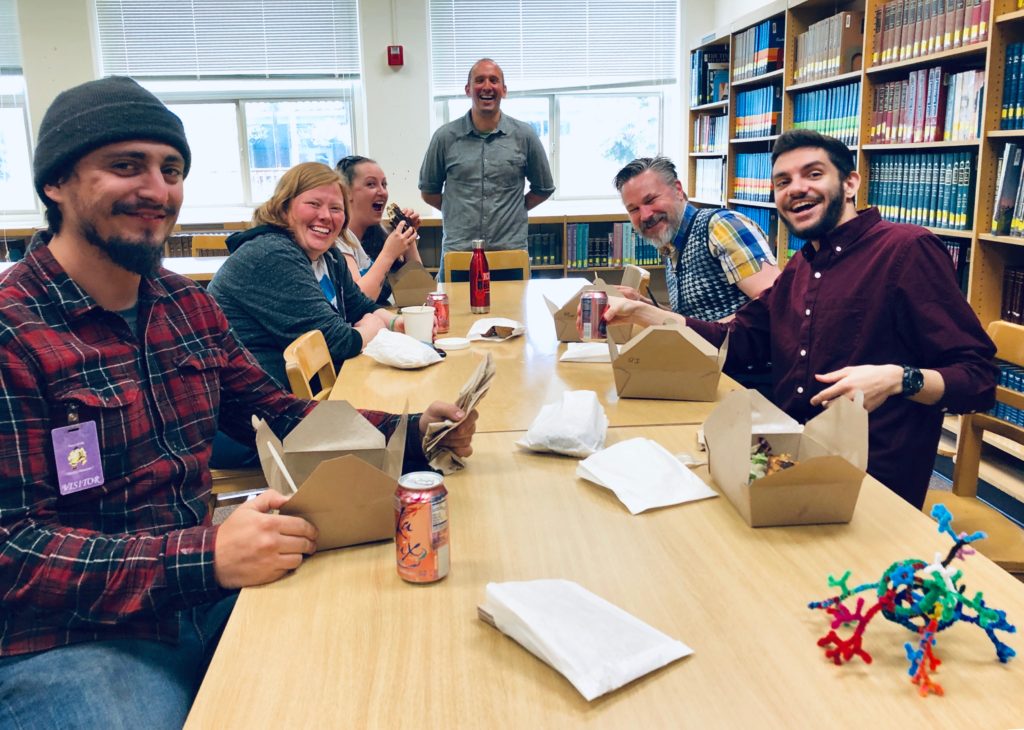
LEARN MORE: Astoria Noggins: Tipsy Buzzed Mice @ Street 14
In the afternoon, art teacher Mickey Cereghino’s Painting and Basic Design course students had more questions about substance use. Several expressed concern about whether having parents dependent on substances meant that you were more likely to end up using or abusing substances yourself. We love explaining that though there is a genetic component to these situations it typically takes a lot more than that. Volunteer Aaron Eisen calls it “a perfect storm” of contributing factors that lead to substance abuse. Some factors that a teen can control that may help them successfully avoid use disorders include “a supportive community, and access to resources.” He added that “avoiding episodes of binge use in your youth can be a large predictor of successful avoidance of genetically correlated substance dependence in adulthood.”
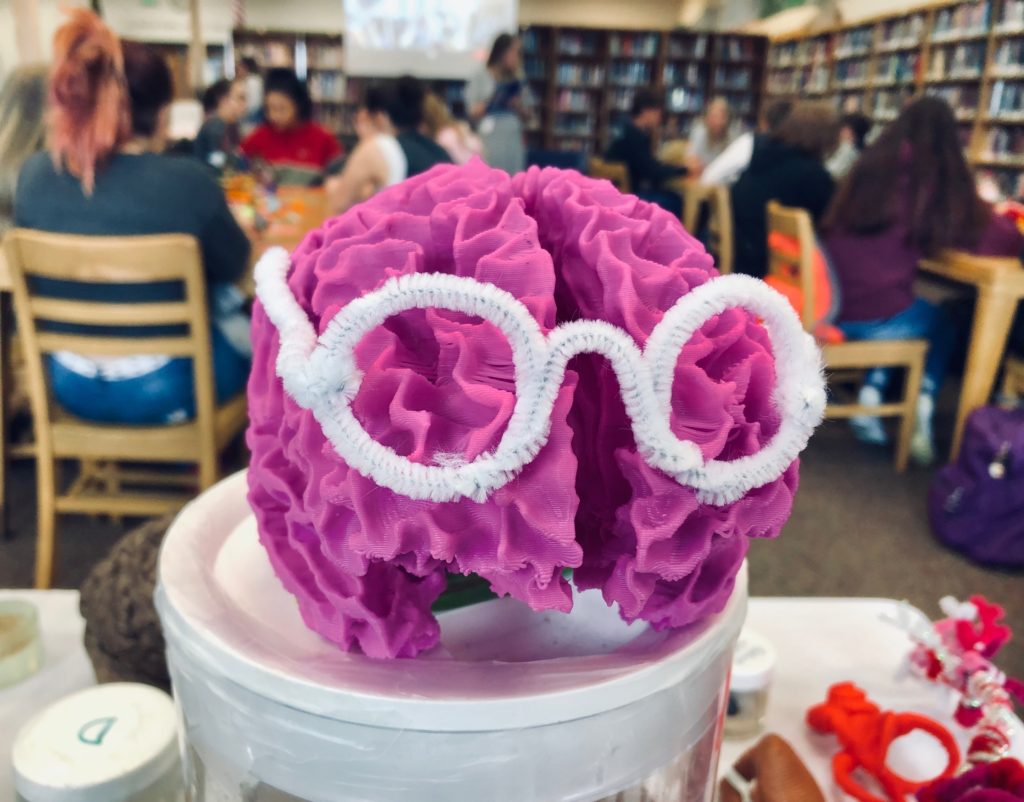
LEARN MORE: The Genetic Basis of Addictive Disorders
LEARN MORE: The Genetics of Substance Dependence
LEARN MORE: Genetics and Epigenetics of Addiction
LEARN MORE: Genes and Addictions
Both students and teachers asked questions about circadian rhythms and the value of moving school start times to accommodate teens’ normal shifts in their pattern of sleep/wakefulness. Some teens are unable to fall asleep until 2:00, 3:00, even 4:00 in the morning; even if they ‘go to bed,’ they often just lay there and are unable to sleep. Teens need a wake up time that is shifted to later in the day in order to be awake enough to learn…
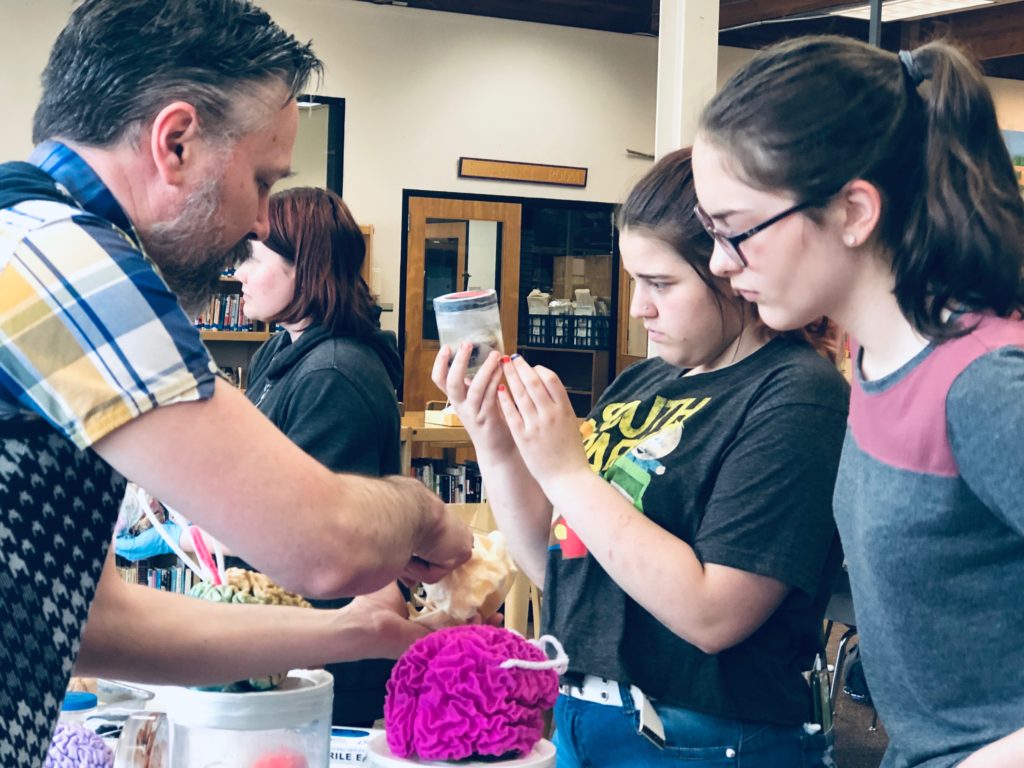
LEARN MORE: Brains, biofeedback & SLEEP
One teacher asked “If they shifted the school start time, wouldn’t the kids’ circadian rhythms just shift forward too?” A recent study from Seattle Public Schools suggests that the answer is no, finding sustained, substantial benefits in mental health, academic performance and attendance from shifting forward by just one hour…
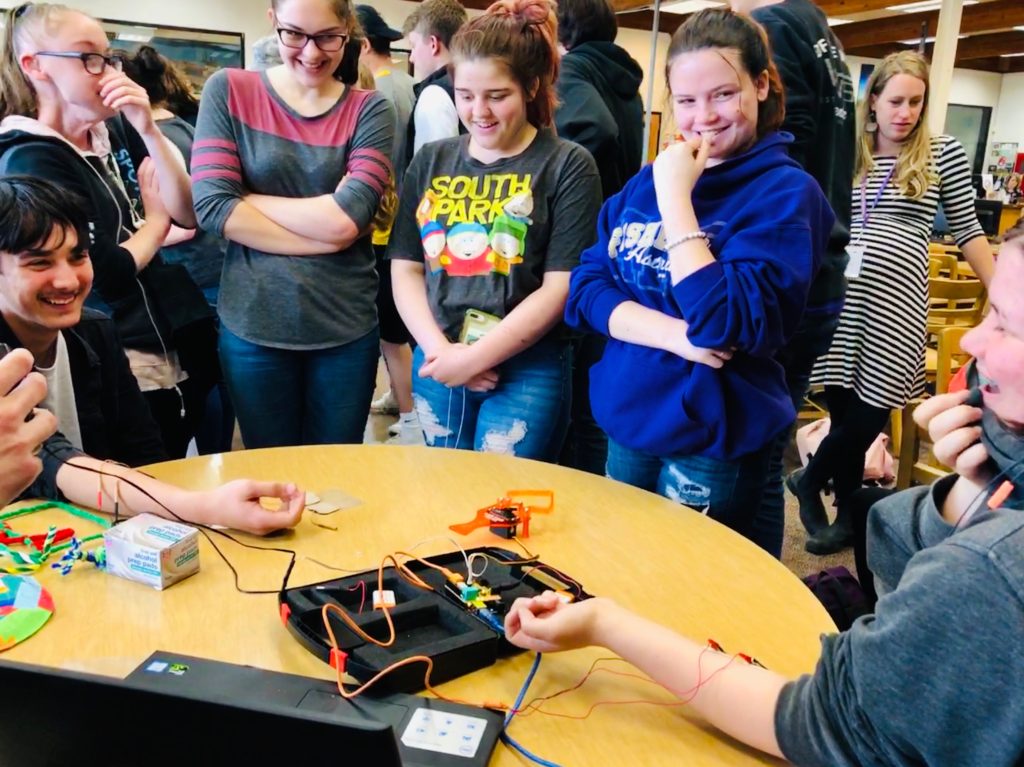
Another teacher asked why the kids seem to have an “increase of energy around the 2:00 o’clock hour,” and we discussed how their ability to inhibit behavior is affected by being tired.
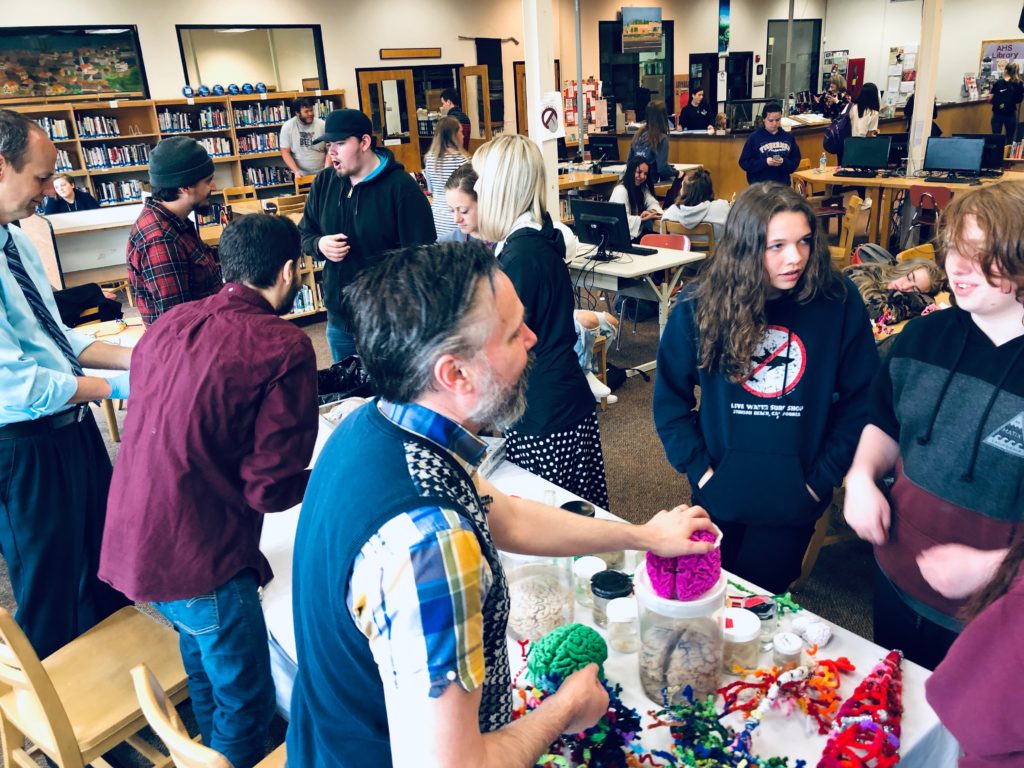
We also discussed how contact with the blue light from screens close to bed time can delay sleep onset, and how long term sleep disturbance can impair learning, increase stress and even contribute to neurodegenerative illnesses like dementia later in life.
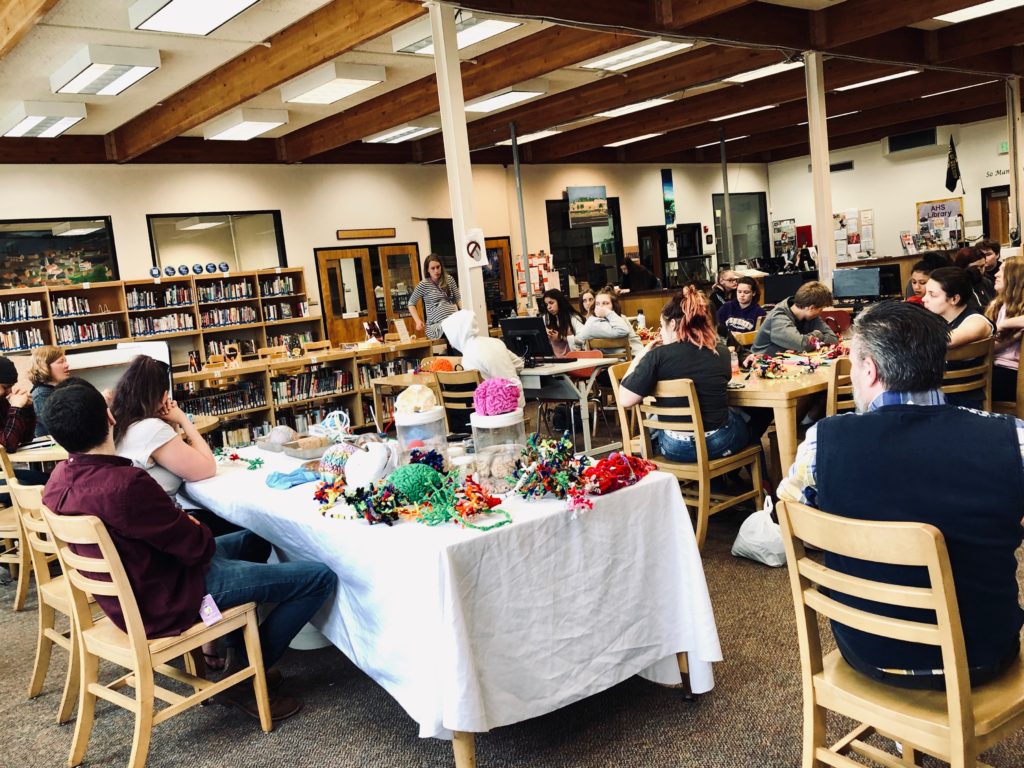
LEARN MORE: Exposure to Room Light before Bedtime Suppresses Melatonin Onset and Shortens Melatonin Duration in Humans
LEARN MORE: Linking Light Exposure and Subsequent Sleep
LEARN MORE: Short- and long-term health consequences of sleep disruption
LEARN MORE: Sleep Disorders: In Depth
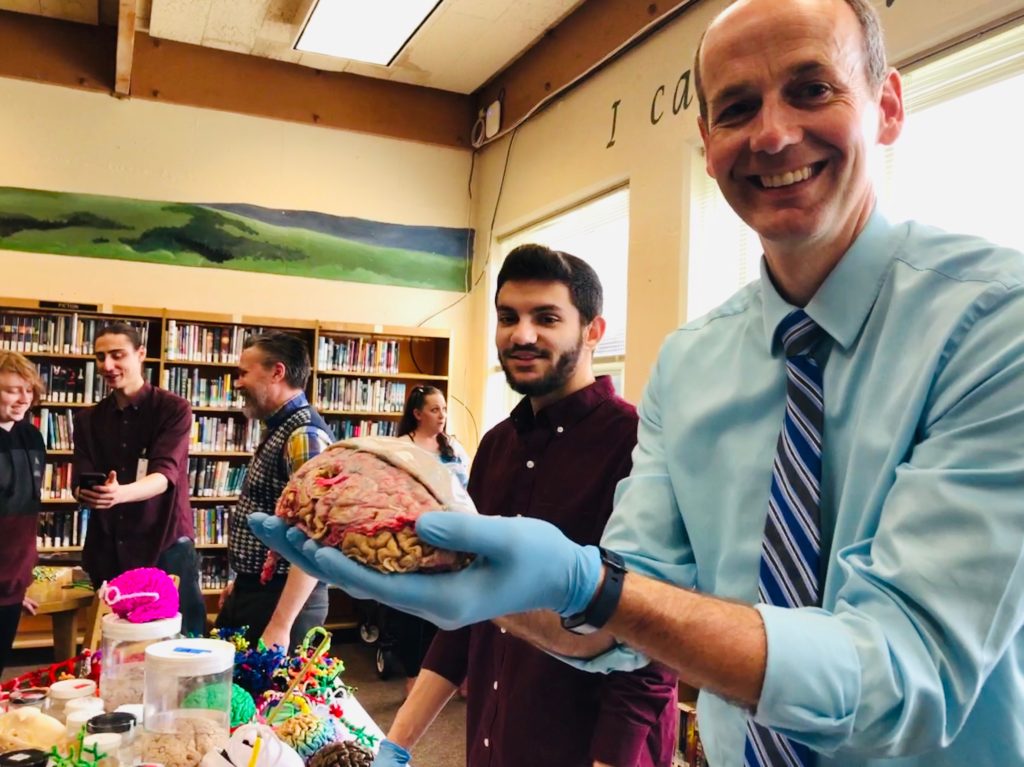
Principal Lynn Jackson came in to listen for a while, watch his students make a few pipe cleaner neurons, and even hold a real human brain!
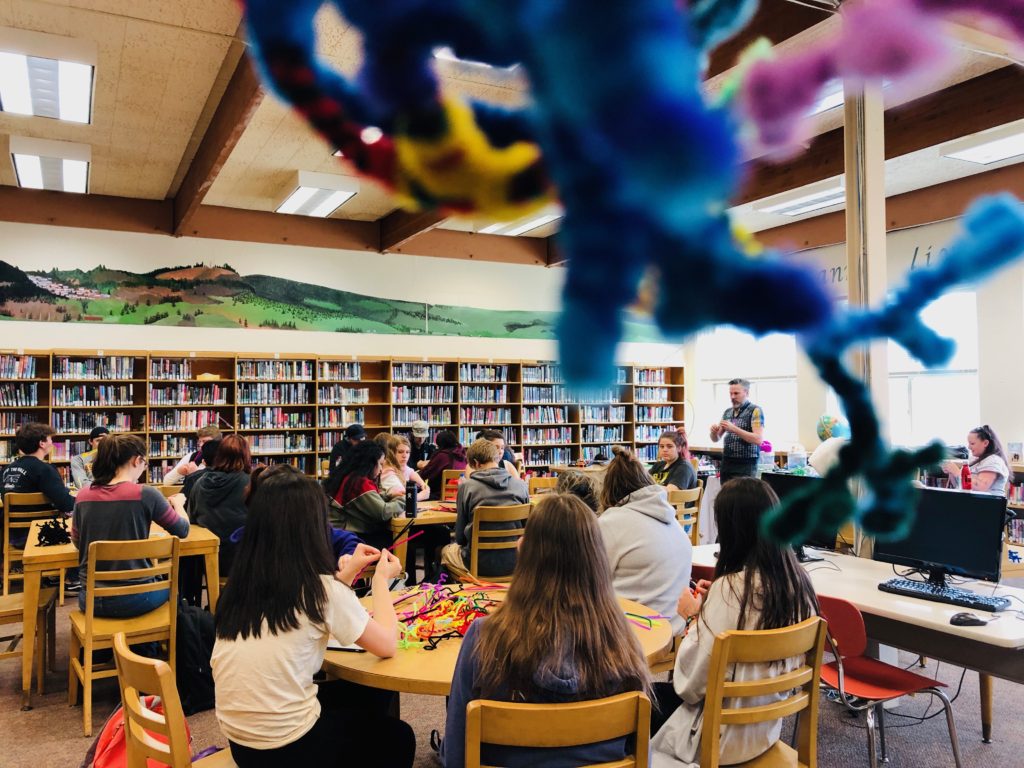
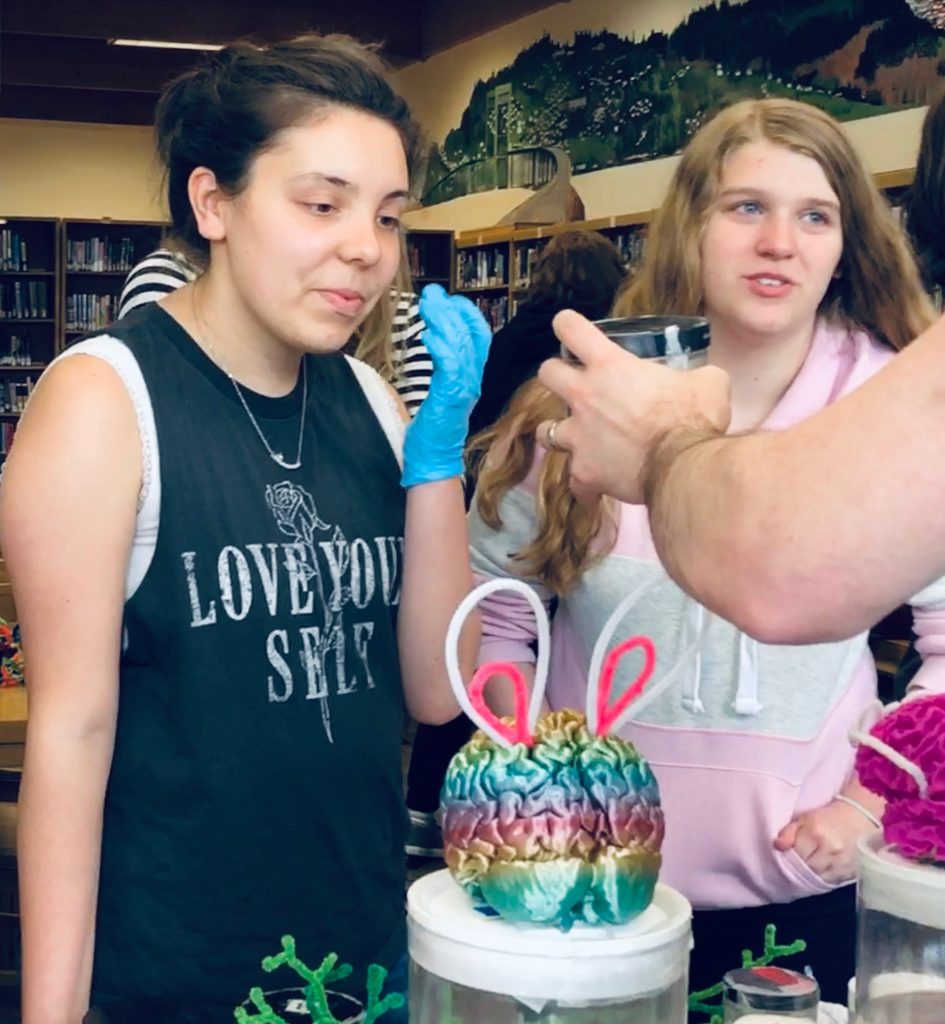
It is always fun, and always an honor, to be a part of a vibrant, unscripted, arts-integrated learning environment. The students and staff at Astoria High School were amazing and welcoming, including librarian Tiffiny Ploghoft. Thank you Meredith, Tiffiny, Lynn, Chad and Mickey for introducing us to such astute, creative, and very curious young people! We look forward to a return…
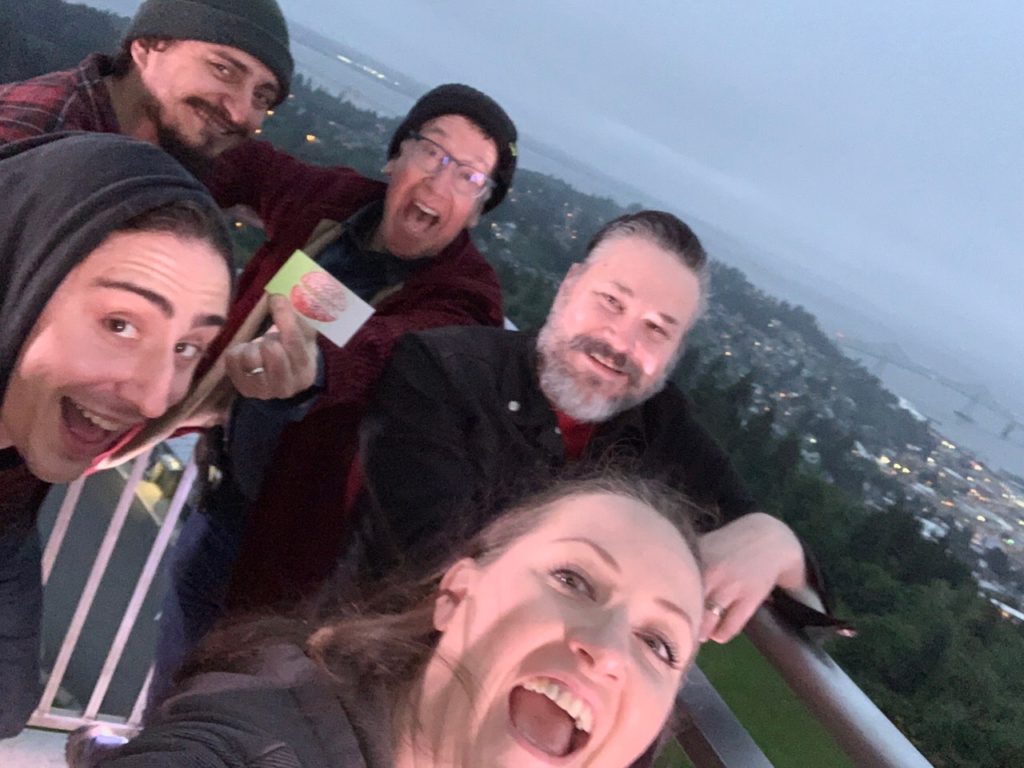
Thanks also to our INCREDIBLE NOGGIN VOLUNTEERS!! We cannot say enough about your expertise, enthusiasm, and willingness to share who you are, what you know, and how you think with others all over the Pacific Northwest, and beyond. You DO STUFF, and it’s appreciated!!
